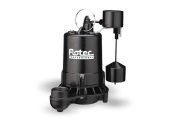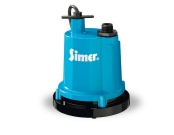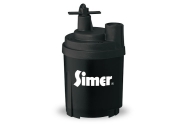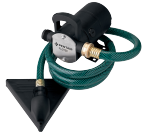- Home
- Education & Support
- Water Education Center
- How to Prepare for a Flood in Your Home
How to prevent flooding in your home
According to Floodsmart.gov, flooding is the No. 1 natural disaster in the U.S. There are many preventative measures you can take to be prepared in case a flood threatens your home. It's important to be proactive in creating prevention plans as well as formulating appropriate responses if preventable actions fail and your house does become flooded.
Prepare for Seasonal Flooding
Flooding can happen in any season, but you can take precautions to prevent water damage at different times of the year. These seasonal weather patterns will be important to keep in mind when preparing for flooding.
SPRING
During spring thaw, melting snow can overflow lakes and riverbanks. Add spring rains to that abundance of water, and your home may be in danger of flooding. Severe flooding in the Midwest during spring has occurred many times over the years.
SUMMER
Thunderstorms in summer can bring heavy rains, sometimes over a period of several days, resulting in flooding in low lying areas. Some areas even experience flash floods during summer storms.
SUMMER/FALL
Hurricane season runs from June through November and during these months, locations along the East and Gulf coasts are vulnerable to storm surge and torrential rains. Even inland locations can be affected by rising floodwaters and ensuring your home is properly protected is vital to prevent damage.
WINTER
While big winter storms get headlines for bringing snow days to the north, they can also cause major rainfall in the warmer southern states. These big wintry snow dumps can lead to a buildup of snow that eventually leads to a big spring thaw.
Protecting Your Home
Sump pumps play an important role in preventing your home from flooding. These pumps are installed in your basement or crawl space and are designed to safely pump water away from your home.
Featured Sump Pumps
Pentair Flotec 1/3-HP 115-Volt Submersible Thermoplastic Sump Pump
- Corrosion-resistant thermoplastic and engineered alloy construction
- Vertical on/off float switch for smaller basins
Pentair Flotec 1/2 HP Submersible Thermoplastic Sump Pump
- Corrosion-resistant thermoplastic and engineered alloy construction
- Vertical on/off float switch for smaller basins
Pentair Flotec 3/4 HP Submersible Cast Iron Sump Pump
- Rugged cast-iron construction for longer pump life
- Energy-efficient PSC motor for smoother, quiet operation
Pentair Flotec 1/3 HP Submersible Thermoplastic Sump Pump
- Engineered Alloy motor housing for extended use
- Corrosion-resistant zinc body
How to Stop Flooding in Your Home
If you live in a high-risk area, it may be inevitable that your home will flood. Luckily, there are steps you can take to minimize the damage to structural elements and possessions in your home.
6 WAYS TO MINIMIZE FLOOD DAMAGE
- Check your roof - Be sure that gutters and drains are clear of debris so rainwater can flow away from your home instead of seeping in through your roof or pooling at the base of your home.
- Check the foundation - Find cracks and close them with expandable products such as hydraulic cement so water doesn't seep into your basement.
- Move expensive items higher - When furnaces and water pumps are installed, make sure they are at least 12 inches above the known flood level for your area. Move valuable items to higher levels to avoid potential flood damage in low-lying areas.
- Keep wastewater from backing up - Install sewer or septic line check valves, which will prevent your sewage from ending up in the standing water in your home.
- Mitigate water damage - Once power sources like furnaces and water heaters are turned off and cool, you can wrap them up in waterproof tarps. Also make sure fuel tanks are anchored so they don't float or rupture.
- Document your property - Take photos and videos of all the damage your property sustained. If you have flood insurance, it'll be necessary to show proof of what has been affected.
4 Steps to Take After a Flood
- Before clean up, take photos of all damage for insurance claims.
- Remove water as soon as possible with a Pentair sump or utility pump and discharge hose.
- Dry your home using dehumidifiers and fans.
- Scrub floors and surfaces with a bleach solution of one cup of bleach to one gallon of water.
Use a Utility Pump to Remove Water
Utility pumps are multipurpose pumps that can be used for everyday applications around your home, but are also designed to handle unexpected flooding. These pumps help remove standing water from your home after a weather event and help mitigate flood damage.
Featured Utility Pumps
Pentair Flotec 1/6 HP Tempest Water Removal Utility Pump
- Multipurpose pump for emergency basement and sump draining, emptying ponds, appliances, wash down and roof dewatering
Pentair Simer Cast Aluminum Submersible Utility Pump
- Heavy-duty cast aluminum construction
- Easy-to-operate
- Includes garden hose adapter
Pentair Simer 1/4 HP Submersible Utility Pump
- Rugged thermoplastic construction
- Simple "plug-it-in-to-run" operation
- Includes garden hose adapter
Pentair Simer Mini-Vac Utility Pump Kit
- Simple operation using two garden hoses
- Easy-to-operate and easy-to-service design
Additional Flood Information and Resources
Curious if you live in a high-risk flood area? Learn more about areas most commonly affected by flooding and steps to take if flooding occurs in your home. Take advantage of these easy tools to help determine if you live in a flood zone and information on flood insurance.










